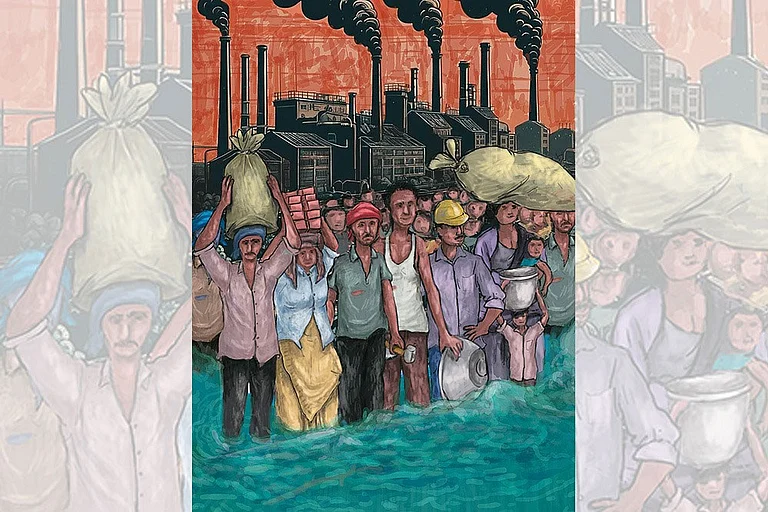As a child, I was mesmerized by my grandma's eerie tales of lightning strikes. She would recount stories of ‘Mama-Bhanja’—a maternal uncle and nephew struck down by lightning while seeking refuge under the same tree. Her voice would drop to a whisper, emphasizing the deadly power of nature. These stories, though bone-chilling, were abstract to me yet conveyed the unforgiving might of the elements. Their reverence and the imprints they left on my mind remain with me to this day.
Many years later, after my grandma passed away, my life took a turn. I moved to the hills of Himachal Pradesh to pursue a career as a journalist. The tranquility of the mountains was a stark contrast to the hustle and bustle of Rohtak, the Haryana town where I spent the initial years of my career.
I fell in love with the serene climate of the hills, the work environment, and the people—the newsmakers and consumers alike. The monsoon rains were nothing short of enchanting. I would watch as clouds engulfed Shimla’s seven hills, where the town—the erstwhile summer capital of British India—was developed by the British. Summers were spent in the cool, pleasant climate, with the winter snow and monsoon rains adding to its charm.
A young doctor, (late) Hardyal Chauhan, my next-door neighbor, often deepened my sense of rejuvenation and wonder in Shimla. He would say, “Here in Shimla, nature’s beauty and tranquility blend effortlessly. It’s the perfect place to unwind, my friend!” His words made the experience even more magical, transforming everyday moments into assured exuberance.
Those monsoon times were truly mesmerizing. The tall deodars—the green legacy of Shimla—inspired me to write several off-beat stories. Storytelling became a profound accomplishment in the truest sense.
Years after my stint in Raipur, Chhattisgarh (2002-2005), fate brought me back to Shimla. However, the town had transformed significantly, with notable changes in its air and skyline. The monsoon delight was missing. It was then that I found myself reflecting on my grandma’s tales about nature’s retribution, warning of the devastating consequences that could follow if nature were violated, over-exploited, disrespected, and ill-treated.
Stories of frequent cloudbursts, natural disasters, and landslides in the fragile hills began unfolding before me. The Himalayas, often revered as ‘Devbhumi,’ are experiencing devastating times. The situation is undoubtedly severe, with the monsoons becoming increasingly frightening.
Climate change, global warming, and human activities over recent years have driven the hills to horrific devastation in living memory. Cloudbursts are now a familiar occurrence, leading to flash floods that erase traces of human settlements. Each event leaves behind a trail of death, destruction, and suffering, with the scale and frequency increasing with each passing monsoon.
In Samej village, for example, a cloudburst wreaked unimaginable havoc. Torrential rains, falling in a matter of minutes after the cloudburst, swept away everything in their path. Giant boulders and mudslides obliterated everything, resulting in the loss of more than 50 lives, including 16 members of a single family and eight schoolchildren.
The monsoon floods of 2023 are still fresh in people’s memories, with visuals of Mandi’s ancient Panchvaktra temple submerged in the Beas River going viral. The relentless rains and massive landslide in Shimla took a heavy toll, claiming 20 lives, including seven members of a single family at Shiv Bhawdi temple. Buildings collapsed like houses of cards, and deodars came crashing down on roads, houses, and some of the old cottages—heritage landmarks.
Ever since then, monsoon rains have caused sleepless nights for the natives of Shimla hills, especially when accompanied by lightning and thunderstorms. Landslides—the falling slopes—could be fatal, causing immense agony for families.
This year, the summer was particularly warm, evidence of rising temperatures in the mountains. Scientists at HP’s Department of Environment and Climate Change acknowledge the glaring truth—the Himalayan ecosystem is crumbling faster than expected. Climate change is a reality, as Suresh Attri, a climate change expert, asserts.
In his recent paper, Attri wrote, “The recent cloudbursts occurred in a specific direction, starting from the Dhauladhar ranges towards Chanderkhani and Deotibba to the Zanskar ranges, almost in a straight line, meaning that locally accumulated temperature differentials at ground level caused the warming effect and the incident.”
Attri explains that cloudbursts are often associated with convective clouds, such as cumulonimbus clouds, which can release large amounts of water in a short span of time. These events are characterized by a rapid accumulation of precipitation, sometimes leading to flash floods, landslides, and other forms of water-related disasters.
Cloudbursts are perilous occurrences that necessitate robust preparedness and reliable early warning systems to minimize their effects on communities and safeguard lives and property.
Uttarakhand, too, faces severe challenges. The 2013 Kedarnath tragedy, which resulted in over 5,700 deaths, was one of the worst and most terrifying disasters.
The once tranquil Himalayan landscape, now impacted by warming temperatures, deforestation, and reckless construction on fragile hillsides, has become more vulnerable. More than 400 glacier lakes also pose a threat. Environmental neglect, combined with a surging population, has turned the monsoons in the hills into a formidable threat for indigenous communities and natives who once lived in harmonious balance with nature. This stark reality echoes the wisdom of our grandmothers: "Respect nature—it can provide for all, but it cannot tolerate greed.”

















